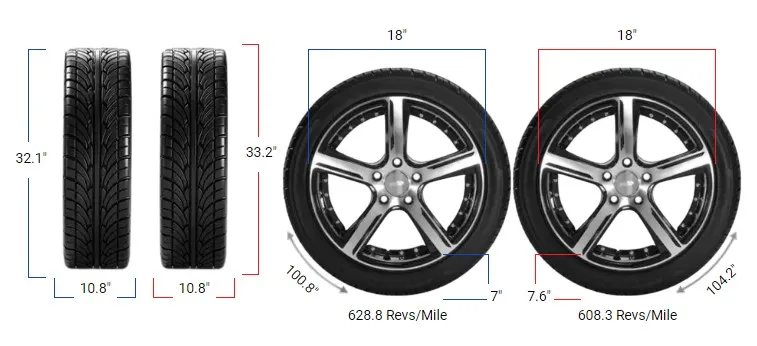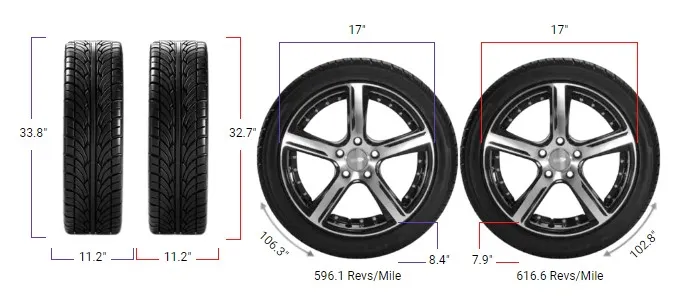Tire Size 275/55r20 vs 33×12.50r20

Switching from 275/55r20 to 33×12.50r20 tires involves a significant change in size and performance. Let’s explore the impacts of this tire switch and what it means for your driving experience.
- Larger diameter increases ground clearance by 1.11 inches
- Wider tread may improve off-road traction but reduce fuel efficiency
- Taller sidewall height could result in a softer ride
- Speedometer will read about 3.5% slower than actual speed
- Tire revolutions decrease by 21.27 per mile affecting odometer readings

Fitment Guide
The diameter difference between 275/55r20 and 33×12.50r20 tires is 3.5%, which slightly exceeds the recommended range of 3%.
This means the interchange is not typically recommended without making necessary adaptations to prevent issues like rubbing or clearance problems.
On-Road Impact
Switching to 33×12.50r20 tires will noticeably affect your vehicle’s on-road performance. Here’s what you might experience:
- Gas Mileage: The larger diameter of the 33×12.50r20 tires means they make fewer revolutions per mile (21.27 less, or a 3.4% decrease). This could lead to a slight decrease in fuel efficiency due to increased rolling resistance and the tire’s wider profile.
- Speedometer Accuracy: Your speedometer will be affected by this change. When it reads 20 mph, your actual speed will be about 20.7 mph. This 3.5% difference could lead to unintentional speeding if not accounted for.
- Ride Comfort: The taller sidewall height (0.56 inches or 9.3% more) of the 33×12.50r20 tires may result in a softer ride. You might feel fewer road imperfections and bumps, especially on rougher roads.
- Aesthetics: The wider width (1.69 inches or 15.6% more) and larger overall size of the 33×12.50r20 tires will significantly change your vehicle’s appearance. It will likely look more aggressive and have a slightly higher stance due to the larger tires.
- Handling: The wider width could improve traction, especially in dry conditions. However, it might also increase the risk of hydroplaning in wet weather and could make the steering feel heavier.

Off-Road Impact
For off-road enthusiasts, the switch to 33×12.50r20 tires can bring substantial changes:
- Ground Clearance: The larger diameter will increase your vehicle’s ground clearance by about 0.555 inches (half of the 1.11-inch diameter increase). This can be beneficial when navigating over obstacles or through deep ruts.
- Traction: The wider width of the 33×12.50r20 tires will provide better traction in most off-road conditions, including mud, sand, and loose gravel. This can significantly improve your vehicle’s off-road capability.
- Durability: The taller sidewall height of the 33×12.50r20 tires makes them more resistant to damage from rocks and other off-road hazards. This could lead to improved durability in challenging terrain.
- Flotation: The increased width and overall size of the 33×12.50r20 tires will provide better flotation in soft terrains like sand or deep mud. This can help prevent your vehicle from getting stuck in these conditions.
275/55r20 vs 33×12.50r20 Table
This table compares the key features of the tire sizes 275/55R20 and 33×12.50R20.
| Feature | 275/55R20 | 33×12.50R20 | Difference |
|---|---|---|---|
| Diameter inches (mm) | 31.91 (810.5) | 33.02 (838.72) | 1.11 (28.22) +3.5% |
| Width inches (mm) | 10.83 (275) | 12.52 (318) | 1.69 (43) +15.6% |
| Circumference inches (mm) | 100.25 (2546.26) | 103.74 (2634.92) | 3.49 (88.66) +3.5% |
| Sidewall Height inches (mm) | 5.95 (151.25) | 6.51 (165.36) | 0.56 (14.11) +9.3% |
| Revolutions per mile (km) | 632.04 (392.73) | 610.78 (379.52) | -21.27 (-13.21) -3.4% |
| Speedo Reading | 20 mph | 20.7 mph | +0.7 mph |
What is the Difference Between 275/55r20 and 33×12.50r20?
The main differences between 275/55r20 and 33×12.50r20 tires are in their dimensions. The 33×12.50r20 is larger overall, with a diameter of 33.02 inches compared to 31.91 inches for the 275/55r20.
The 33×12.50r20 is also significantly wider at 12.52 inches versus 10.83 inches for the 275/55r20. Additionally, the 33×12.50r20 has a taller sidewall and makes fewer revolutions per mile.

Can I Use 33×12.50r20 Instead of 275/55r20?
While it’s possible to use 33×12.50r20 instead of 275/55r20, it’s not typically recommended without making necessary adaptations.
The difference in diameter between these two tire sizes is 3.5%, which slightly exceeds the generally accepted 3% threshold for tire replacement.
This size difference could affect vehicle performance, safety, and accuracy of speedometer and odometer readings, potentially requiring vehicle modifications.
How Much Taller Is a 33×12.50r20 Tire Than a 275/55r20?
A 33×12.50r20 tire is 1.11 inches (28.22 mm) taller than a 275/55r20 tire. The 33×12.50r20 has a diameter of 33.02 inches (838.72 mm), while the 275/55r20 has a diameter of 31.91 inches (810.5 mm). This represents a 3.5% difference in height.
How Much Wider is a 33×12.50r20 Tire Than a 275/55r20?
A 33×12.50r20 tire is 1.69 inches (43 mm) wider than a 275/55r20 tire. The 33×12.50r20 has a width of 12.52 inches (318 mm), while the 275/55r20 has a width of 10.83 inches (275 mm). This represents a 15.6% difference in width.
Our Observation
Switching from 275/55r20 to 33×12.50r20 tires offers a mix of benefits and challenges. On-road, you may experience reduced fuel efficiency and speedometer inaccuracy, but gain a softer ride and improved dry traction.
Off-road, the benefits are more pronounced, with increased ground clearance, better traction, and improved durability. The 3.5% size difference slightly exceeds recommended guidelines, so this switch may require vehicle modifications.
The impact is significant for both on-road and off-road use, with off-road performance seeing the most substantial improvements. Drivers should carefully consider their primary usage and be prepared for potential modifications to accommodate these larger tires.



